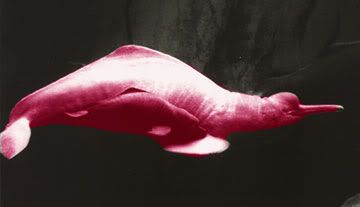The Pink Amazonian River Dolphins

Ever since I heard about the Amazonian Pink River Dolphins (I can't remember when), I was amazed that such unique creatures are still alive and living in our planet earth. Dolphins amuse me. They always have. I, on the other hand, also have a habit of categorizing or labeling people that I meet as certain specified animals, apart from my psychoanalytical behaviour. As for me, I always thought I am a Pink Amazonian River Dolphin. Here is a short info on this wonderful amazing creature. Have fun reading. Click on link above for more info.
Of the five freshwater species of dolphins in the world, the pink Amazon River dolphin, Inia geoffrensis, or "bufeo colorado" as they are known in Peru and "botos" as they known in in Brazil, are considered to be the most intelligent.
These friendly, sensitive, mammals with a brain capacity 40% larger than that of humans, who have lived in harmony with the people of the Amazon and its tributaries for centuries, now face extinction in some tributaries. What was considered to be one of the least threatened species of dolphins 20 years ago, has now become one of the most endangered species due to the accelerated and commercialized rape of the Amazon basin and the destruction of the South American tropical rainforest.
No one knows the actual number of Inia geoffrensis that live n the Amazon basin, but according to the reseach and studies that Roxanne Kremer has conducted in the Upper Basin of the Peruvian Rainforest, 150 kilometers upstream of Iquitos, Peru, the number of pink dolphins from 18 years ago has risen from eight pink dolphins on the Yarapa River to 35 to 45. Ms. Kremer counted the dolphins in July 1998. ISPTR believes that her work with the Peruvian Forest Police to protection both species of river dolphins, and empowering the local peoples of their rights and use of the law, there has been less illegal commercial fishing and logging in the area, thus saving the natural habitat of the land and aquatic life.
The struggle to save these treasured beings as an important link in an ecosystem -- currently being encroached upon by industrialized forces -- is being spear-headed by the non-profit International Society for the Preservation of the Tropical Rainforest (ISPTR), whose first globally known project PARD, the Preservation of the Amazonian River Dolphin.

Pink Dolphin Physical Description
Size: 2.5 to 3 meters (8.25 ft to 9.75 ft) and 90 kilograms (200 lbs.). Males are generally larger.
Habitat and Distribution: Tributaries and main rivers of the Orinoco River systems of South America. They tend to gather at confluences of rivers.
Diet: Crustaceans, catfish and small fresh water fish. A unique characteristic of Inia geoffrensis is the unfused vertebrae in its neck, which allows for the 180-degree head turn, giving them greater flexibility in floodplain forests, grassland, tributaries and shallow waters. They have a hump on their back instead of a dorsal fin.
Coloration: The reasons for the unique coloration of Inia geoffrensis are poorly understood, but the presence of capillaries near the surface of the skin probably accounts for much of its characteristic pink flush. Other factors may include age of the animal, chemical disposition of the water (especially iron content), and the temperature of the water
Intelligence: The intelligence of Amazon River dolphins has not been extensively tested. Their encephalization quotient (the ratio of brain mass to body weight) compares favorably with that of the bottlenose dolphin (Tursiops). The gray dolphins tend to be more "cautious" than the pink dolphins, perhaps because of their small size and very delicate skin. On the other hand, Inia is known for its highly developed sense of curiousity and it rapidly associates with man in a variety of serious and playful ways.
Dolphins and People: Given that these animals are threatened with extinction in certain tributaries, we do not actively seek or encourage overtly "friendly" contact with the Amazon River dolphins. Their chances of survival are greatly enhanced if they remain suspicious of human beings and maintain a certain distance.
Contrary to popular opinion, all dolphins are capable of behaving agressively toward human beings at certain times and under certain conditions. There are a number of reports of pink dolphins pushing people to the shore after their canoes had capsized. The dolphins figure prominently in the local mythology and their reputation varies from one tributary to another. In some locations, the pink dolphins are considered as unpredictable brujos (wizards), and, in other locations, they are benign and helpful semi-divine beings.

A mother dolphin with baby
So, Ken, Jo En, Sheena, Sarah , Yvonne and the rest..... I hope I enlightened you with my little epistle here =)

1 Comments:
i just threw up my lunch..... u're egotism is beyond me!!
i'm reminded of a poem i learnt in form 1.
they call me mr egotistical,
i'm as handsome as can be.
the rest isn't relevant when it comes to u :D 'nuff said!
Post a Comment
Subscribe to Post Comments [Atom]
<< Home